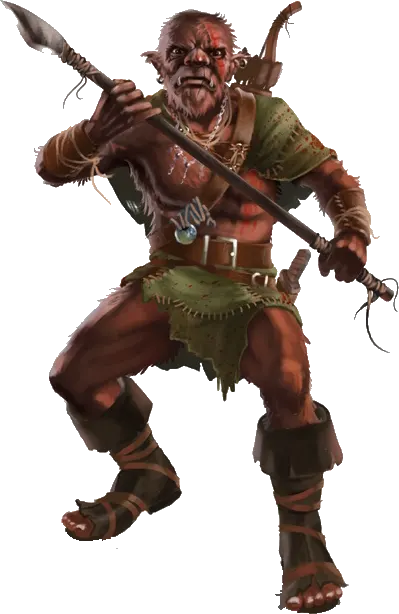“Goblins are smallish creatures. They may have ape-like countenances, but they are able to speak and use simple tools. One can meet them as bandits on the road, as hunters and gatherers in the wilderness, and even in certain cities, like Festum, where they have found their niche catching rats and performing menial tasks for their human masters. Never trust a goblin. They are born thieves.”
— Dame Gilda of Honingen-Salpertin, Almanac of Folklore, Honingen, 921 FB
Of all the intelligent races in Aventuria, goblins might very well be one of the most misunderstood. Goblins are related to orcs, but they stand somewhat smaller than a dwarf on average, their build is wirier, and their slightlystooped bodies are covered head-to-toe in dense, shaggy fur that usually ranges in color from rust red to brown (the source of common slurs against them). They are weaker than orcs, but they are much nimbler and more agile. Their low, prominent brows, protruding teeth, and wide noses give their faces a somewhat ape-like appearance, such that most humans find it hard to believe that an intelligent mind resides within a goblin’s frame. This misjudgment can lead to disaster, as goblins, which have a reputation as thieves and cowards, have one of the oldest cultures in Aventuria. The several hundred thousand goblins known to live on the continent maintain their own culture, their own language, and an impressive shamanistic tradition.
Distribution
Goblin strength is often underestimated in Aventuria. Most have settled in the Green Plains, the Sickle Mountains, and in Nostria and Andergast. One can encounter them in every corner of Aventuria, either as roaming bandits, simple workers, or slaves. Goblins are extremely adaptable and inventive. You can even find white-furred snow goblins living near the hostile coast of the Ice Sea. In most regions of Aventuria, goblins have no rights and are viewed as mere animals. Killing one is no more serious a crime than poaching. Goblin coexistence with humans and other races is indeed possible, as demonstrated by the large goblin communities in Festum and Uhdenberg, where they work as rat-catchers or tanners or serve in other dirty and dangerous trades.
Their human neighbors often look down on them but view their work as a sign of bravery.
Goblins are known to live only in Aventuria, although rumor has it that some live on the Giant’s Shore. They have not spread to the other continents.
Way of Life
Urban goblins have gradually come to adopt the customs and religions of their human neighbors. For that reason, tribal goblins (and the humans themselves) view goblins with mistrust and contempt. Their less “civilized” brothers and sisters in the Sickle Mountains live in family units where women hold prominent positions due to their importance for the creation of progeny. This rural goblin culture is founded on the worship of the divine couple, Mailam Redkai and Orvai Kurim, who are usually depicted as boars that walk upright on two legs. Mailam Redkai, the Great Mother or Mother Sow, created the Suulak (the goblins’ term for themselves). She symbolizes fertility, healing, food, and summer.
Goblin families are led by a wise woman, who often also serves as the family’s shaman. The Great Mother’s male partner, Orvai Kurim, is the lord of hunters. He represents the martial aspects of goblin culture. Goblins view hunting, feuds, and war to be basically similar activities. Orvai Kurim is most often worshiped by male goblins. For that reason, in times of war, the most experienced hunter or warrior of the family assists the wise woman in word and deed. When there is war, goblins ride boars into battle, a sight which many experienced knights find ridiculous. As anyone who has been trampled by an angry boar can tell you, it is no laughing matter.
Goblins have no known written language, and little is known of the history of the goblins before their first contact with humans. They ruled their own kingdoms in northern Aventuria millennia ago, and 800 years ago, an empire of goblins covered the Bornland. The Order of the Theater Knights put an end to goblin expansion but suffered heavy losses in the process. One should never underestimate the goblins. One goblin might look weak and scared, but they rarely travel alone. In hunting groups or armies, they can prove very dangerous.
Tribal goblins wander the wilderness, but gangs of goblins can be found almost anywhere in central and northern Aventuria. These bands are comprised mainly of young males who have left their homes to achieve fame and fortune through thievery and robbery. They pursue nocturnal raids, burglaries, and any other criminal activities that promise quick rewards.
A Selection of Goblin Names
Female: Garrgh, Jääni, Kashka, Orvazz, Riiba, Rrhuusa, Rukuka, Seenä, Souli, Yaashka
Male: Bluugh, Grrargh, Groinkh, Gurluug, Joraak, Shraa, Sulrik, Traak, Urmeg, Xeetsh


